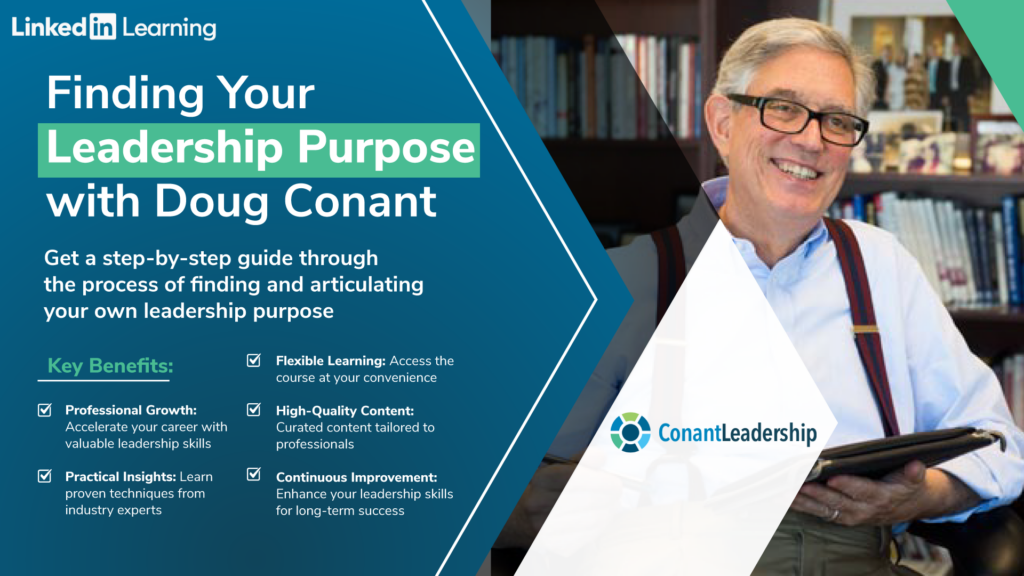At ConantLeadership, we’re committed to lifelong learning and continuous improvement. In service to your leadership growth, each month we curate the Leadership That Works Newsletter, a digest of timely resources from around the web. We prepare this resource in order to:
- Share actionable advice from top leadership luminaries
- Celebrate a range of viewpoints worthy of consideration (inclusion is not an endorsement)
- Contextualize workplace trends through a leadership lens
- Illuminate cultural recalibrations in the world of work
- Support your personal development in life, leadership, and beyond
In this month’s Leadership That Works Newsletter: Employee engagement on the rise, how to think like Leonardo da Vinci, a neuroscientist’s tips for performing under pressure, and more. As always, we’re sharing the content from our newsletter here on our blog in case you’re not subscribed to our mailing list. If you find these links enriching, you can sign up to receive our newsletter right here.
Employee Engagement—and Stress—on the Rise
1. Engagement is on an upswing. “After dropping in 2020 during the pandemic, employee engagement is on the rise again.”
2. Globally, the majority of employees remain disengaged. “Nearly six in 10 employees” are psychologically disengaged and “low engagement costs the global economy 8.8. trillion dollars, or 9% of global GDP.”
3. Employee stress is higher than ever. “Worldwide, 44% of employees said they experienced a lot of stress the previous day.”
4. Job opportunities are surging. “The increase in available jobs signals that the world economy is open for business.”
5. Many employees are on the job hunt. “51% of currently employed workers said they are watching for or actively seeking a new job.”
6. Engagement is more important than where people work. “How people feel about their job has a lot more to do with their relationship with their team and manager than being remote or being on-site.”
7. Disengaged workers want improvement in three primary areas. Employees want improvement in the three key areas of “engagement or culture, pay, and wellbeing,” and are also seeking “more recognition, opportunities to learn, fair treatment, clearer goals, and better managers.”
The report links to in depth analysis and actionable insight for each of the seven findings and you can explore it in its entirety here.
Think Like a Genius: The Leonardo da Vinci Guide
In Michael Gelb’s book published in 2000, How to Think Like Leonardo da Vinci, the author shares seven essential elements of genius gleaned from da Vinci. Now, artist Tanmay Vora brings Gelb’s ideas to new life in this QAspire Consulting “sketchnote” which celebrates the da Vincian principles with vibrant drawings and words. If leaders want to emulate da Vinci and think like a genius, they must embody these seven tenets captured in the sketchnote:
- Curiosità (An Insatiable Curiosity & Thirst for Learning)
- Dimostrazione (Test Knowledge via Practical Experience)
- Sensazione (Constantly Sharpen the Senses)
- Sfumato (Be Comfortable with Ambiguity)
- Arte/Scienza (Develop Balance between Logical & Creative Thinking)
- Corporalita (Develop Poise between Body & Mind)
- Connessione (Maintain a Big Picture Perspective)
Together, these seven tenets represent a peek into the mind of one of history’s most revered thinkers and offer a path to more effective thinking and leading. Get the full story here.
‘How’ Beats ‘Where’ in Distributed Work
A Neuroscientist’s Tips for Performing Under Pressure
“Understanding the interaction between motivational and stress systems is crucial for performance under pressure,” writes neuroscientist Juliette Han in this Forbes piece on how to keep your eye on the prize when the stakes are high. Studies show that medium to large rewards can boost performance, but as stakes or incentives increase to extraordinarily high levels, they can cause people to “choke under pressure.” Han’s advice to “avoid choking,” as pressure mounts are threefold.
1. Take your eyes off the prize. “Focusing on the prize can better your performance up to a certain reward threshold. Once the potential reward becomes exceptionally high, focus instead on the step-by-step execution of the task.”
2. Simulate a high-stakes practice environment. “Prepare and practice for the most complex, difficult situations by visualizing all possible scenarios: questions that would stump you, a non-responsive audience, delays in counterparties, and mishandling of sensitive information.”
3. Create room to decompress. “Researchers found that college students who wrote about their anxieties before taking a math exam showed a 5% improvement on a second test taken under stressful conditions,” showing that finding ways to express worries “frees memory resources and increases the ability to focus.”
Get the full story here.
**For more on this, explore Doug Conant’s post from our archives, “3 important Reasons Why Pressure Is a Privilege.”
Experts Still Agree: Gratitude Is Good for You
**For more on this, explore our post from the archives, “Lead with gratitude,” and engage with the host of resources on gratitude included at the top of this newsletter from November 2022.
Pew Says ‘P.U.’ to Past Generational Framing
If you’ve ever complained that you don’t identify with the traits popularly associated with your generation, you’re not alone. Pew Research Center, which has been at the forefront of generational research in recent history—often framing how the public contextualizes trends attributed to “Gen X,” “Millennials,” “Gen Z,” and “Boomers”—announced drastic changes to their reporting methods on generations in this blog post by Kim Parker, their Director of Social Trends and Research. Moving forward, they hope to set the tone for generational conversations to proceed with more nuance and accuracy.
Parker says, amidst a field “flooded with content” that looks like research “but is more like clickbait,” and against the backdrop of growing criticism of the usefulness of generational labels, Pew decided “to take a step back and consider how we can study generations in a way that aligns with our values of accuracy, rigor, and providing a foundation of facts that enriches the public dialogue.” After a yearlong process of assessment, methodological testing, and experimentation, Pew arrived at the following new guidelines.
1. “We’ll only do generational analysis when we have historical data that allows us to compare generations at similar stages of life.”
2. “Even when we have historical data, we will attempt to control for other factors beyond age in making generational comparisons.”
3. “When we can’t do generational analysis, we still see value in looking at differences by age and will do so where it makes sense.”
4. “When we do have the data to study groups of similarly aged people over time, we won’t always default to using the standard generational definitions and labels.”
Overall, Pew‘s new guidelines aim to help leaders and the public understand employee populations and behavior more deeply. By no longer defaulting to generalizations and catchy buzzwords, Pew intends “to avoid reinforcing harmful stereotypes or oversimplifying people’s complex lived experiences.” Get the full story here.
**For more on this, explore Yahoo‘s coverage of Pew‘s new guidelines.
Improve Your Meetings with ‘Generous Exclusion’
1. “Get clear on your purpose. When we don’t know why we’re gathering, we can over-include.”
2. “Determine who would help most fulfill the purpose this time.”
3. “Think through a way to explain (if you choose to and you feel you want to) the logic of the line with care.”
4. “Stand by your convictions with openness and honesty. By articulating that purpose with care and trust, you’re protecting your guests’ time and experience, and creating a culture of intention (and permission) for others to do the same.”
5. “And when you might find yourself on the opposite end of the stick, be a generous non-guest and defend a host’s right to thoughtfully define a gathering.”
Parker adds that any gathering “is an invitation to become more thoughtful about how you spend your time and with whom.” Get the full story here.
**For more on this, explore Doug Conant’s “CEO Manifesto for Better Meetings.”
What Is the ‘Glass Cliff’?
You’ve likely heard of the “glass ceiling,” the obstacles women face to getting promoted, but what about the “glass cliff,” which is a pernicious barrier to success post-promotion? In this WRAL TechWire coverage of the phenomenon, Nicole Case, a corporate HR veteran, defines the “glass cliff” as “the set up to fail.” She explains the “glass cliff” happens “when companies find themselves in crisis mode,” and “decide to elevate or bring in a woman or another person of a historically marginalized group to quote-unquote ‘turn things around.'” Case says that often women will get the promotion but not “the resources they need to be successful,” and are frequently placed in “impossible situations,” where there is not enough time, money, or personnel to fix the inherited crises. The resulting “glass cliff” is a “win-win for companies that can pat themselves on the back for hiring a woman or person of color,” while leaving the “promoted person very little chance for success and a lot of opportunity for blame.” Get the full story here.
Insights & Resources from ConantLeadership
 Now Available! Our NEW LinkedIn Learning Course: “Finding Your Leadership Purpose with Doug Conant”
Now Available! Our NEW LinkedIn Learning Course: “Finding Your Leadership Purpose with Doug Conant”
Purpose is essential. But it can be a nebulous concept. To help leaders find their own leadership purpose, Doug Conant developed a unique process, and a series of reflection prompts, for finding and writing your one-of-a-kind leadership purpose, which he is elated to share in his new LinkedIn Learning course. Access the course here.
May‘s Leadership That Works Newsletter
 About the Author: Amy Federman is ConantLeadership’s Director of Content and Editor in Chief, and co-author with Doug Conant of the WSJ bestseller, The Blueprint.
About the Author: Amy Federman is ConantLeadership’s Director of Content and Editor in Chief, and co-author with Doug Conant of the WSJ bestseller, The Blueprint.
(Cover photo by Anshul Sharma on Unsplash)






0 Comments